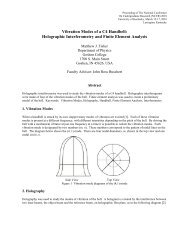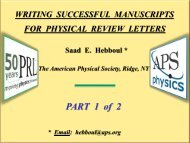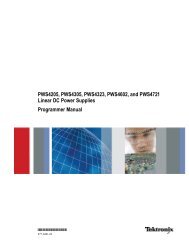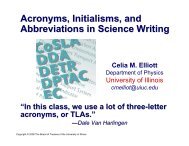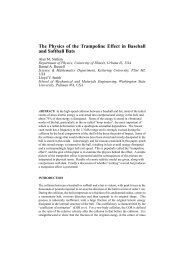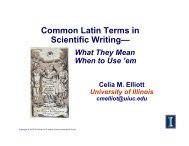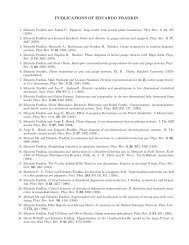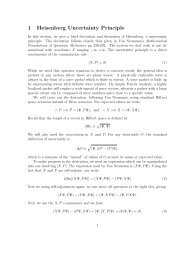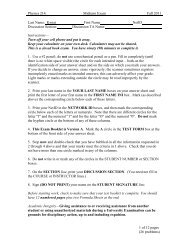Computing - Department of Physics - University of Illinois at Urbana ...
Computing - Department of Physics - University of Illinois at Urbana ...
Computing - Department of Physics - University of Illinois at Urbana ...
Create successful ePaper yourself
Turn your PDF publications into a flip-book with our unique Google optimized e-Paper software.
PHYSICS ILLINOIS NEWS • 2006 NUMBER 1 11About P<strong>at</strong>rick WalshT. P<strong>at</strong>rick Walsh (third from right) in BadakamandraP<strong>at</strong>rick Walsh is a junior, working on a double major in engineering physicsand economics. He originally decided to study physics out <strong>of</strong> philosophicalcuriosity. “I always figured th<strong>at</strong> searching for enlightenment through physicswas more <strong>of</strong> a symbolic gesture than a practical one, but I like physics.L<strong>at</strong>ely I’ve been looking towards less theoretical and more human-orientedapplic<strong>at</strong>ions, so it’s nice to have the ‘engineering’ already in my degree.“I’m interested in the production <strong>of</strong> energy because its scarcity seems tobe the root cause <strong>of</strong> a lot <strong>of</strong> the world’s strife and suffering. Th<strong>at</strong>’s how I gotinterested in the bi<strong>of</strong>uel project, and the understanding <strong>of</strong> basic physics I gothere <strong>at</strong> school helped me to grasp the overall challenges in ways th<strong>at</strong> the morespecialized engineers <strong>at</strong> our level weren’t as able to, so it was a gre<strong>at</strong> fit.”His experience in India taught Walsh th<strong>at</strong> the problem <strong>of</strong> energy productionand distribution in the developing world must be addressed in a much biggerway. “I’m now interested, first, in long-term development <strong>of</strong> technologies th<strong>at</strong>will increase global energy production by orders <strong>of</strong> magnitude, and second,in short-term development <strong>of</strong> technologies th<strong>at</strong> will directly benefit the world’spoor.”Walsh has gotten involved this semester in a fusion energy research projectin the <strong>Department</strong> <strong>of</strong> Nuclear, Radiological, and Plasma Engineering, and he’llbe working on a plasma gun experiment for his senior thesis in <strong>Physics</strong>.He is also trying to organize a project to raise some investment capital tomass produce solar-charged, b<strong>at</strong>tery-oper<strong>at</strong>ed LED lanterns to replace some<strong>of</strong> the >1 billion inefficient kerosene lamps used now in the developing world.He just wrote a proposal to the US Environmental Protection Agency forseed-funding for the project.Walsh says he’s “up in the air” on future plans. “I know I’ll have to picksomething to concentr<strong>at</strong>e on soon, and make a decision about grad schooland such. I don’t know if I want to do research or work on policy issues orsome combin<strong>at</strong>ion <strong>of</strong> the two; I’m looking for advice!”If you have career advice to <strong>of</strong>fer, contact the editor <strong>at</strong> cmelliot@uiuc.edu. ■Ramsey <strong>at</strong> AAS<strong>Physics</strong> undergradu<strong>at</strong>e CaitlinRamsey was the center <strong>of</strong> <strong>at</strong>tentionon January 9, when NASAAdministr<strong>at</strong>or Michael Griffin stoppedby to ch<strong>at</strong> about her poster, “AnOptical Study <strong>of</strong> Stellar and InterstellarEnvironments <strong>of</strong> Seven Luminous andUltraluminous X-ray Sources,” <strong>at</strong> theAmerican Astronomical Society annualmeeting in Washington DC.Ramsey, a junior from Rochester,<strong>Illinois</strong>, <strong>at</strong>tended the meeting withYou-Hua Chu, pr<strong>of</strong>essor <strong>of</strong> astronomy<strong>at</strong> <strong>Illinois</strong>, who supervised herundergradu<strong>at</strong>e research project.Caitlin used archival Hubble SpaceTelescope images to identify the opticalcounterparts <strong>of</strong> the ultraluminous x-raysources (ULXs) Ho IX X-1 and NGC1313 X-2 and made photometricmeasurements <strong>of</strong> the local stellarpopul<strong>at</strong>ions <strong>of</strong> these and the luminoussource IC 10 X-1 (C.J. Ramsey, et al.,“An Optical Study <strong>of</strong> Stellar andInterstellar Environments <strong>of</strong> SevenLuminous and Ultraluminous X-RaySources,” Astrophys. J. 641, 241-251[2006]).A highlight <strong>of</strong> the conference forRamsey was a talk given by Vera Rubinabout the early years <strong>of</strong> her career inastronomy in the 1950s, and herinstrumental role in the discovery <strong>of</strong>dark m<strong>at</strong>ter. Ramsey herself was raisedon Carl Sagan’s Cosmos series andbecame more seriously interested inphysics and astronomy when, <strong>at</strong> age 11,she audited an undergradu<strong>at</strong>e course <strong>at</strong>Sangamon St<strong>at</strong>e <strong>University</strong> (now<strong>University</strong> <strong>of</strong> <strong>Illinois</strong>, Springfield) withPr<strong>of</strong>essor <strong>of</strong> Astronomy and <strong>Physics</strong>Charles Schweighauser.Ramsey is preparing for a seniorthesis project this summer with S.Lance Cooper, a condensed m<strong>at</strong>terexperimentalist. Her future plans areto pursue a PhD in biophysics andbiomedical engineering.About her trip to AAS, Ramseynoted, “A number <strong>of</strong> pr<strong>of</strong>essors andstudents from other universities, aswell as independent astronomers, wereinterested in my poster, and I am gladth<strong>at</strong> I was able to answer a lot <strong>of</strong>questions th<strong>at</strong> morning. This was agood opportunity to learn about thework th<strong>at</strong> others were doing in x-rayastronomy and with ULXs.” ■[Eds. note: Funding for Caitlin’s <strong>at</strong>tendance <strong>at</strong> theAAS meeting was provided by the <strong>Department</strong> <strong>of</strong><strong>Physics</strong>’ Excellence in <strong>Physics</strong> endowment. If youwould like to contribute to the fund, so th<strong>at</strong> we cancontinue to support worthy student activities, pleasesee www.physics.uiuc.edu/support/excellence.html.]NASA Administr<strong>at</strong>or Michael Griffin talks with Caitlin Ramsey <strong>at</strong> the AAS meeting inJanuaryAAS photo by Kelley Knight, © 2006 American Astronomical Society<strong>Physics</strong> Website Gets New LookThe department has recently undertaken a complete overhaul <strong>of</strong> its 18-GB, >16,000-page website,giving it a fresh new look.“People have been asking me, ‘Why change?’” said Celia Elliott, department webmaster. “Whilethe old site was content rich and straightforward to navig<strong>at</strong>e, the look was very d<strong>at</strong>ed and did not,I believe, reflect the st<strong>at</strong>ure <strong>of</strong> the department. The site was also getting harder and harder to maintainas it grew—each page was hard-coded HTML. If we wanted to change something in the footer, we hadto make the change 16,000 times, one page <strong>at</strong> a time. The old pages also relied on tables for layout,which are not accessible to anyone having a visual impairment who relies on a screen reader.“Thus, we had three major design goals: get a more up-to-d<strong>at</strong>e look, meet or exceed federalaccessibility guidelines, and switch to cascading style sheets (css) for easier maintenance.Unfortun<strong>at</strong>ely, doing any <strong>of</strong> these things was far beyond my abilities,” Elliott added, “but we gotwonderful help from the <strong>University</strong>’s Office <strong>of</strong> Cre<strong>at</strong>ive Services and their web designer, ValerieLohmann. Val was able to take my vision and transl<strong>at</strong>e it into a beautiful design and idiot-pro<strong>of</strong>css templ<strong>at</strong>es th<strong>at</strong> I was able to use.”The project has not been without its setbacks. “Oh, it’s like any other do-it-yourself project I’ve everundertaken,” Elliott laughed. “It took ten times longer than I expected, cost twice as much, and pushedme waaaaay beyond the limits <strong>of</strong> wh<strong>at</strong> I could do competently. Fortun<strong>at</strong>ely, I got gre<strong>at</strong> support fromVal and people here in the department, particularly Gabe Gibson, Becky McDuffee, Mark Tomory,and Johnetta Wilde. We’d still be looking <strong>at</strong> the old pages if it hadn’t been for them.”Plans for the future? “Before we do this again, I’m going to be the former webmaster,” said Elliott.Check out the new look <strong>at</strong> www.physics.uiuc.edu. ■UNIVERSITY OF ILLINOIS AT URBANA-CHAMPAIGN






